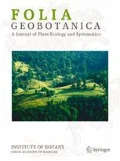Abstract
Many authors apply statistical tests to sets of relevés obtained using non-random methods to investigate phytosociological and ecological relationships. Frequently applied tests include thet-test, ANOVA, Mann-Whitney test, Kruskal-Wallis test, chi-square test (of independence, goodness-of-fit, and homogeneity), Kolmogorov-Smirnov test, concentration analysis, tests of linear correlation and Spearman rank correlation coefficient, computer intensive methods (such as randomization and re-sampling) and others. I examined the extent of reliability of the results of such tests applied to non-random data by examining the tests requirements according to statistical theory. I conclude that when used for such data, the statistical tests do not provide reliable support for the inferences made because non-randomness of samples violated the demand for observations to be independent, and different parts of the investigated communities did not have equal chance to be represented in the sample. Additional requirements, e.g. of normality and homoscedasticity, were also neglected in several cases. The importance of data satisfying the basic requirements set by statistical tests is stressed.
Similar content being viewed by others
References
Bishop Y.M.M., Fienberg S.E. &Holland P.W. (1975):Discrete multivariate analysis: theory and practice. MIT Press, Cambridge. [Reference for electronic appendix]
Botta-Dukát Z. &Ruprecht E. (2000): Using concentration analysis for operating with indicator values: effect of grouping species.Acta Bot. Hung. 42: 55–363.
Chytrý M., Tichý L. &Roleček J. (2003): Local and regional patterns of species richness in Central European vegetation types along the pH/calcium gradient.Folia Geobot. 38: 429–442.
Dierschke H. (1994):Pflanzensoziologie. Grundlagen und Methoden. Eugen Ulmer, Stuttgart.
Ellenberg H, Weber H.E., Düll R., Wirth W., Werner W. &Paulißen D. (1991): Zeigerwerte von Pflanzen in Mitteleuropa.Scripta Geobot. 18: 1–248.
Ewald J. (2003): The calcareous riddle: why are there so many calciphilous species in the Central European Flora?Folia Geobot. 38: 357–366.
Gibbons J.D. (1971):Nonparametric statistical inference. McGraw-Hill Company, New York.
Hájek M, Hekera P. &Hájková P. (2002): Spring fen vegetation and water chemistry in the Western Carpathian flysch zone.Folia Geobot. 37: 205–224.
Henry G.H.R. (1998): Environmental influences on the structures of sedge meadows in the Canadian High Arctic.Pl. Ecol. 134: 119–129.
Hoaglin D.C., Mosteller F. &Tukey J.W. (1983):Understanding robust and explanatory data analysis. John Wiley & Sons, New York
Hoaglin D.C., Mosteller F. &Tukey J.W. (1985):Exploring data tables, trends, and shapes. John Wiley & Sons, New York.
Johnson J.B. (1997): Stand structure and vegetation dynamics of a subalpine treed fen in Rocky Mountain National Park, Colorado.J. Veg. Sci. 8: 337–342.
Kendall M. &Stuart A. (1977):The advanced theory of statistics 1: Distribution theory. Griffin & Company Ltd., London. [Reference for electronic appendix]
Kendall M. &Stuart A. (1979):The advanced theory of statistics 2: Inference and relationship. Griffin & Company Ltd., London. [Reference for electronic appendix]
Kenkel N.C., Juhász-Nagy P. &Podani J. (1989): On sampling procedures in population and community ecology.Vegetatio 83: 195–207.
Kreeb K.H. (1983):Vegetationskunde. Methoden und Vegetationsformen unter Berücksichtigung ökosystemischer Aspekte. Eugen Ulmer, Stuttgart.
Kruskal W. (1988): Miracles and statistics: the casual assumption of independence.J. Amer. Statist. Assoc. 83: 929–940.
Lájer K. (2000): Self-organising structure in tussock patterns.Acta Bot. Hung. 42: 211–224.
Lájer K. (2001):Magyarország lápi vegetációjának növénytársulástani vizsgálata (A phytocenological treatise on the Hungarian mire vegetation). PhD. Thesis, University of Pécs, Pécs.
Lájer K. (2002): Florisztikai és cönológiai vizsgálatok a somogyi Dráva-völgy rétjein (Floristic and cenological studies on meadows of the Somogy county valley of river Drava).Kitaibelia 7: 187–205.
Lawesson J.E. (2003): pH optima for Danish forest species compared with Ellenberg reaction values.Folia Geobot. 38: 403–418.
Lele S.R. &Richtsmeier J.T. (2001):Statistical analysis of shapes. Chapman & Hall/CRC, Boca Raton, Florida.
Lepš J. &Hadincová V. (1992): How reliable are our vegetation analyses?J. Veg. Sci. 3:119–124.
Lundekvam H.E. &Gauslaa Y. (1986): Phytosociology and ecology of mowed grasslands in Western Norway.Meld. fra norges landbrukshogskole 65(22): 1–26.
Machol R.E. (1975): The Titanic coincidence.Interfaces 5: 53–54.
Matus G. &Tóthmérész B. (1990): The effect of grazing on the structure of a sandy grassland. In:Krahulec F., Agnew S. &Willems J.H (eds.),Spatial processes in plant communities, SPB Academic Publishing, The Hague, pp. 23–30.
Ohlson M., Økland R.H., Nordbakken J-F. &Dahlberg B. (2001): Fatal interactions between Scots pine andSphagnum mosses in bog ecosystems.Oikos 94: 425–432.
Økland R.H. &Bendiksen E. (1985): The vegetation of the forest-alpine transition in the Grunningsdalen area, Telemark, SE Norway.Sommerfeltia 2: 1–224.
Orlóci L. &Kenkel N.C. (1985):Introduction to data analysis with examples from population and community ecology. International Co-operative Publishing House Failand, Maryland.
Rédei T., Botta-Dukát Z., Csiky J., Kun A. &Tóth T. (2003): On the possible role of local effects on the species richness of acidic and calcareous rock grasslands in Northern Hungary.Folia Geobot. 38: 453–467.
Rényi A. (1977):Wahrscheinlichkeitsrechnung mit einem Anhang über Informationstheorie. VEB Deutscher Verlag der Wissenschaften, Berlin. [Reference for electronic appendix]
Ripley B.D. (1981):Spatial statistics. Wiley, New York.
Ruprecht E. &Botta-Dukát Z. (2000): Long-term vegetation textural changes of three fen communities near Cluj-Napoca (Romania).Acta Bot. Hung. 42: 265–284.
Schaffers A.P. &Sýkora K.V. (2000): Reliability of Ellenberg indicator values for moisture, nitrogen and soil reaction: a comparison with field measurements.J. Veg. Sci. 11: 225–244.
Schuster B. &Diekmann M. (2003): Changes in species density along the soil pH gradient — evidence from German plant communities.Folia Geobot. 38: 367–379.
Sekuler R. &Blake R. (1994):Perception. Ed. 3. McGraw-Hill, Inc. New York.
Sokal R.R. &Rohlf F.J. (1981):Biometry. The principles and practice of statistics in biological research. Ed. 2. Freeman and Company, New York.
Staudte R.G. &Sheather S.J. (1990):Robust estimation and testing. Wiley, New York.
Wołek J. (1997): Species co-occurrence patterns in pleustonic plant communities (classLemnetea). Are there assembly rules governing pleustonic community assembly?Fragm. Florist. Geobot. Suppl. 5: 3–100.
Author information
Authors and Affiliations
Corresponding author
Rights and permissions
About this article
Cite this article
Lájer, K. Statistical tests as inappropriate tools for data analysis performed on non-random samples of plant communities. Folia Geobot 42, 115–122 (2007). https://doi.org/10.1007/BF02893878
Received:
Revised:
Accepted:
Issue Date:
DOI: https://doi.org/10.1007/BF02893878




